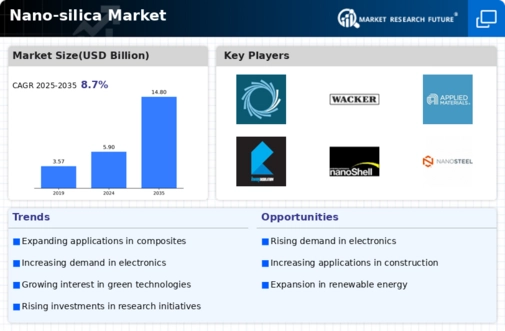Market Growth Projections
The Global Nano-silica Market Industry is projected to experience substantial growth, with estimates indicating a market value of 5.9 USD Billion in 2024 and a potential increase to 14.8 USD Billion by 2035. The compound annual growth rate (CAGR) is anticipated to be 8.72% from 2025 to 2035, reflecting the increasing adoption of nano-silica across various sectors. This growth trajectory suggests a robust demand for nano-silica, driven by its diverse applications and the ongoing advancements in technology. The market's expansion is indicative of the material's versatility and its critical role in future innovations.
Advancements in Electronics
Technological advancements in electronics are significantly influencing the Global Nano-silica Market Industry. Nano-silica is utilized in the production of semiconductors and electronic components, enhancing their performance and reliability. As the demand for smaller, more efficient electronic devices rises, the incorporation of nano-silica is expected to increase. The market's growth is indicative of the broader trend towards miniaturization in electronics, which is projected to contribute to the industry's expansion. This sector's evolution suggests a promising future for the Global Nano-silica Market Industry, particularly as innovations continue to emerge.
Rising Demand in Construction Sector
The Global Nano-silica Market Industry experiences a notable surge in demand driven by the construction sector. Nano-silica enhances the mechanical properties of concrete, leading to improved durability and strength. As urbanization accelerates, the need for high-performance construction materials becomes increasingly critical. In 2024, the market is projected to reach 5.9 USD Billion, reflecting the growing adoption of nano-silica in various construction applications. This trend is likely to continue as infrastructure projects expand globally, indicating a robust growth trajectory for the Global Nano-silica Market Industry.
Innovations in Biomedical Applications
Innovations in biomedical applications are emerging as a key driver for the Global Nano-silica Market Industry. Nano-silica is increasingly utilized in drug delivery systems and medical diagnostics due to its biocompatibility and ability to enhance therapeutic efficacy. The growing emphasis on personalized medicine and advanced healthcare solutions is likely to propel the demand for nano-silica in this sector. As research progresses, the potential applications in biomedicine may expand, further solidifying the role of nano-silica in healthcare. This trend indicates a promising avenue for growth within the Global Nano-silica Market Industry.
Growth in Renewable Energy Applications
The Global Nano-silica Market Industry is poised to benefit from the increasing focus on renewable energy technologies. Nano-silica is employed in the production of solar panels and wind turbine components, enhancing their efficiency and lifespan. As global energy policies shift towards sustainability, the demand for materials that support renewable energy initiatives is likely to rise. This trend could lead to a significant increase in market value, with projections indicating a growth to 14.8 USD Billion by 2035. The integration of nano-silica in renewable energy applications underscores its potential role in advancing global sustainability efforts.
Environmental Regulations and Sustainability
Environmental regulations and the push for sustainable materials are influencing the Global Nano-silica Market Industry. As industries face increasing scrutiny regarding their environmental impact, the demand for eco-friendly materials is rising. Nano-silica, known for its low environmental footprint, is becoming a preferred choice in various applications, including coatings and composites. This shift towards sustainability is likely to drive market growth, as companies seek to comply with regulations while enhancing product performance. The Global Nano-silica Market Industry appears well-positioned to capitalize on this trend, aligning with global sustainability goals.







